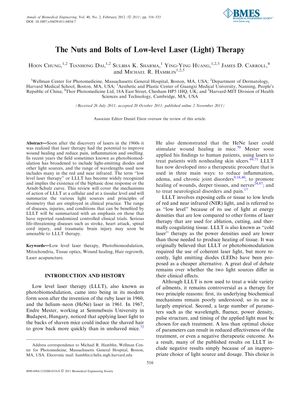The Nuts and Bolts of Low-Level Laser Therapy
November 2011
in “
Annals of Biomedical Engineering
”

TLDR Low-level Laser Therapy may help reduce inflammation, pain, and aid healing, but more research is needed to confirm its effectiveness and establish standard treatment guidelines.
The 2011 document reviews Low-level Laser Therapy (LLLT), highlighting its potential in reducing inflammation, edema, and chronic joint disorders, promoting healing, and treating neurological disorders and pain. LLLT works by stimulating mitochondria with red and near-infrared light to increase ATP production and modulate reactive oxygen species, leading to improved cell function and healing. The review discusses the debate over light sources, with lasers and LEDs being the main focus, and the importance of selecting the right parameters, including wavelength and dosage, to achieve a beneficial effect. It also notes the biphasic dose response, where lower doses can be more effective than higher ones. While LLLT shows promise for serious conditions like stroke and traumatic brain injury, the document calls for more extensive clinical trials to confirm its efficacy, particularly in wound healing, where results have been mixed. A review of 16 trials with 820 patients indicated effectiveness in reducing neck pain, but standardized parameters are needed for broader clinical application.

